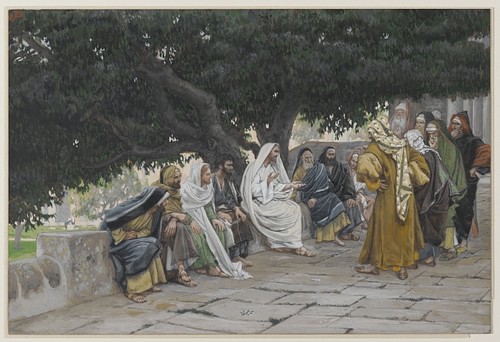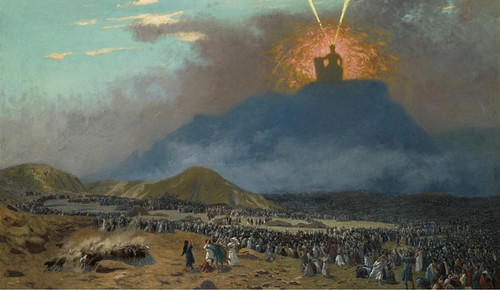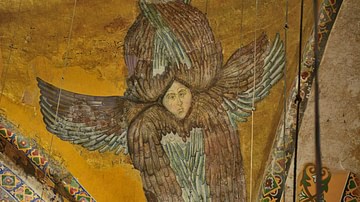
The Pharisees were a Jewish sect that emerged c. 150 BCE and promoted the idea of priestly purity for all Jews, belief in providence or fate, and the concept of the resurrection of the dead, and taught that besides the commandments, Oral Law was also passed down by Moses. Early Rabbinical Judaism in the 2nd century CE claimed spiritual descent from the Pharisees.
Origins
After the conquests of Alexander the Great (r. 336-323 BCE) in 330 BCE, Greek government, language, philosophy, religion, and education, were adopted by the conquered people in the Mediterranean Basin. When Alexander died in 323 BCE, his empire was divided up among his generals during the Wars of the Diadochi. One of these generals, Seleucus I Nicator founded the Seleucid Empire in the region of Syria. In 167 BCE, the Seleucid Antiochus IV Epiphanes (r. 175-164 BCE), outlawed all Jewish customs, which resulted in the Maccabean Revolt led by the Hasmonean family, where the Jews were successful in repelling the Greeks and establishing their own kingdom.
However, not everyone was happy with Hasmonean rule, which combined the office of the king with the high priest of the Temple in Jerusalem. Kingship in Israel was to be held by a descendant of King David's tribe, Judah. During this period, the high priest had to derive from the descendants of Zadok, the last high priest under the reign of Solomon. The Hasmoneans could claim neither line.
This is the period when we find evidence of what scholars term 'Jewish sectarianism.' Various groups of Jews formed sects within the religious body. All agreed on the basics under the Law of Moses and the Books of the Prophets. One of the dominating issues was how to live in this now cosmopolitan Greek culture and yet retain the unique identity markers and traditions of the Jews. Among these sects, we see the emergence of a group known as Pharisees. Their name remains problematic; it may either mean "to be separated" or "smoothers of rough things" in Hebrew.
Pharisee Concepts
The book of Leviticus outlined special purity rituals and criteria for the priests serving in the Temple. All ancient religions had ritual purity laws, and many of them utilized water rituals, but it was not necessarily related to hygiene. Ritual purity was a state of being. Pharisees promoted the idea that all Jews should adopt this priestly purity as well as Temple rituals in their everyday lives.
Pharisees were often quite literal in organizing daily life. They built their houses near one another so that they could share meals and visit on the Sabbath, which restricted how far one could walk. They built mikvaot (singular: mikvah), a stone pool of natural, flowing water to restore ritual purity in front of their houses. During meals, Pharisees symbolically measured a tenth (the tithe) of the meal and set aside as belonging to God.
Because of such views, Pharisees were often at odds with the party of the Sadducees who oversaw the daily operation of the Temple. According to later Rabbinical writings, Pharisees disagreed with the Sadducees over ritual purity issues in the ways in which contagion could be transferred from stone vessels.
The Sanhedrin, the ruling council in Jerusalem, consisted of Sadducees, Pharisees, the high priest, other priests, and aristocratic leaders who had demonstrated the ability to act as sages. One of the more famous of these sages, Hillel (d. c. 10 CE) became the source for later teachings that were organized in the first Rabbinical schools (see below). One of his more famous teachings was: "That which is hateful to you, do not do to your fellow. That is the whole Torah; the rest is the explanation; go and learn." (Babylonian Talmud, Shabbat 31a). This was incorporated into the teachings of Jesus of Nazareth, known as the 'Golden Rule.'
The Oral Law
The Pharisees were noted for their claim that in addition to the Law of Moses (incorporated into many books in the Jewish Scriptures), Moses also passed down oral traditions that were not written down at the time (Hebrew: Torah she-be-‘al peh, "Torah that is in the mouth"). These were given to the Elders who were at Mount Sinai and taught to each generation down to their descendants, the Pharisees. The Oral Law included interpretations on codes of conduct, rituals, worship, interpersonal relationships, dietary laws, festivals, marital relations, and claims for damages.
One of the functions of the Oral Law was to either reinterpret Mosaic Law or to update it in the sense that, over time, certain issues and concerns were not addressed in the original legislation. For example, it was forbidden to work on the Sabbath. However, 'work' was not defined in detail. The Pharisees found a passage that said if your ox falls into a ditch on the Sabbath, of course, you rescue it. By extension, the Pharisees taught that life always takes precedence over any laws of the Torah.
The Theology of the Pharisees
The God of Israel was considered the creator of the universe and all life on earth. He was believed to be omnipotent, all-wise, all-knowing, and all-present. When humans were created, they were given two impulses; to do evil or to do good; according to this belief system, humans have free will to choose. The study of the Torah was to be interpreted through rationality (given to humans by God), considering the conditions of every age since the revelation of the commandments at Sinai. At the same time, however, although humans were free to choose, they also promoted the idea of providence or fate.
In reflecting on the national disasters of Israel (the Assyrian conquest of the Northern Kingdom in 722 BCE and the Babylonian conquest and destruction of the Temple and Jerusalem in 587/586 BCE), the Prophets of Israel had predicted that God would act in human history one time, in the final days. At that time, all the enemies of Israel would be destroyed in a final battle, followed by a final judgment. All the dead would be raised and judged, either to be condemned to Gehenna (the Jewish form of Hell), or to live in a new utopia, the Garden of Eden on earth, as originally planned by God. The Pharisees were one of the first Jewish sects to promote the concept of the resurrection of the dead.
The Great Jewish Revolt of 66 CE
From the 30s to the 60s, the Roman government sent a series of corrupt and inept magistrates to the region, which resulted in a revolt against Rome led by the sect of Jews known as Zealots. The revolt ended in disaster when the Roman emperor Vespasian's (r. 69-79 CE) son, Titus (r. 79-81 CE), laid siege to Jerusalem and destroyed the Second Temple complex. According to the Jewish historian Flavius Josephus (36-100 CE) and later Rabbinic traditions, a Pharisee by the name of Yohanan ben Zakkai negotiated with Vespasian to leave the city in a coffin (along with others). Claiming that the Pharisees only wanted peace with Rome, he established a school at the town of Yavne along the coast. With the Temple gone, he taught that Jews should focus on the teachings of Moses, stressing prayer over sacrifices. Other Pharisees settled in Galilee and developed similar schools.
This is the beginning of Rabbinical Judaism, and from these sources, later texts were developed that are now incorporated into the Talmud, or the entire collection of Jewish thought. One of the first undertakings was to commit the Oral Law to writing, known as the Mishnah. This was completed under the auspices of Rabbi Judah the Prince by c. 200 CE. The rabbis also wrote on Halakah, or the details of Jewish law for everyday life, and the Aggadah were commentaries on biblical narratives. A Sanhedrin was reconstituted as a law court.

An historical problem with the study of the ancient Pharisees is that prior to the destruction of the Temple, very little literature has survived from their early history. The early Rabbinic literature dates to the 2nd century CE. In those writings, the rabbis claim spiritual descent from the Pharisees. However, when they discuss specific teachings and issues, we cannot determine which ones were relative for the earlier period. The writings of only one Pharisee in this period have survived, that of Paul the Apostle. Paul had much to say concerning whether the new Gentile believers should undergo Jewish identity markers, but throughout his letters he consistently praised the Temple and its practices.
The Pharisees in the New Testament
The Pharisees are well-known for their role in the four gospels of the New Testament. Mark, the first gospel (69/70 CE), argued that from the beginning of the ministry of Jesus, the Pharisees were determined to kill him. In the 'conflict dialogues' (Jesus and Pharisees in debate), the Pharisees play the oppositional foil for the teachings of Jesus. The negative polemic against the Pharisees (and the Sadducees) was the rationalization of why God had permitted the Temple to be destroyed. Mark blamed the death of Jesus on the Jews and not Rome because Mark's Jews had to live in the Roman Empire.
The historical problem remains that modern theologians and historians continue to utilize the polemic of the gospels to reconstruct what Pharisees thought and taught in the 1st century CE. Polemic, however, is not evidence. The Pharisees are frequently blamed for oppressing the poor and keeping salvation from their people, but as one of a several Jewish sects, the Pharisees had no authority to impose their ideas on all Jews.







